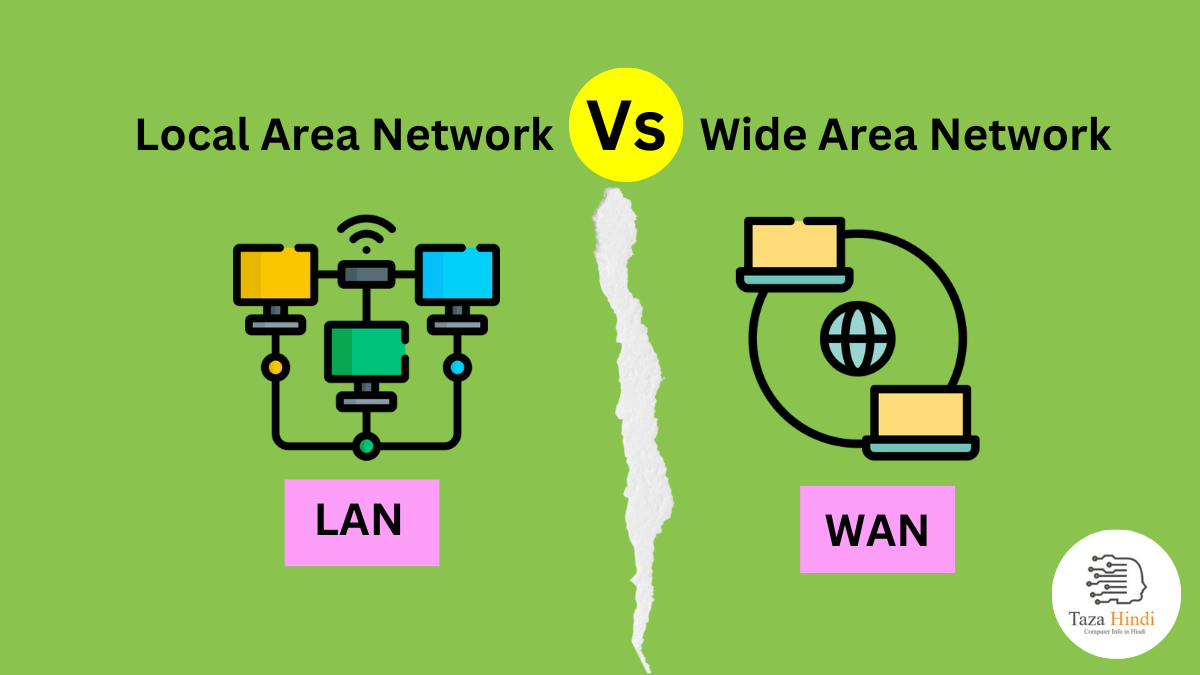In today’s digital age, computer networks play a crucial role in connecting devices and facilitating communication and data sharing. Two commonly used types of computer networks are LAN and WAN. While both serve the purpose of connecting computers and devices, there are significant differences between them. In this article, I will explain what is the importance of computer networks, their characteristics, components, advantages and how to implement LAN and WAN and finally explore the difference between LAN and WAN.
Importance of computer networks
Computer networks have become essential in various aspects of our lives. They enable the sharing of resources, such as files and printers, facilitate communication through email and messaging applications, and provide access to the internet. Networks also enhance productivity, enable collaboration, and streamline operations in both home and office environments. Understanding the distinctions between LAN and WAN can help users choose the appropriate network type based on their requirements.
What is LAN?
LAN, or Local Area Network, refers to a network that connects computers and devices within a limited geographical area, such as a home, office building, or school campus. It allows for the sharing of resources and data between connected devices, offering a localized network environment.
Characteristics of LAN
LANs possess several distinct characteristics:
- Limited geographical area: LANs cover a small physical area, typically confined to a building or a group of buildings.
- High data transfer rates: LANs provide fast data transfer speeds within the network due to the localized nature of the network.
- Private ownership: LANs are privately owned and controlled by individuals or organizations, allowing for greater control over network management and security.
- Low error rate: Due to the short distances involved, LANs experience fewer errors and have lower latency compared to wide area networks.
- Simple network design: LANs usually have a relatively straightforward network design, making them easier to set up and maintain.
Also Read : Top 10 Recommended Books for Computer Science Students
Scope and coverage of LANs
LANs are commonly used in homes, offices, schools, and small businesses. They provide efficient connectivity within a specific area, allowing users to share files, printers, and other resources seamlessly. LANs are ideal for situations where high-speed communication and resource sharing are required within a localized environment.
Components of a LAN
To create a functional LAN, several components are required:
- Network Devices: LANs utilize various network devices, including routers, switches, hubs, and access points. Routers enable communication between devices within the LAN and also facilitate connections to external networks such as the internet. Switches and hubs are responsible for interconnecting devices within the LAN, while access points provide wireless connectivity.
- Media: LANs employ different types of media to transmit data, such as Ethernet cables (e.g., twisted pair, fiber optic) and wireless connections (e.g., Wi-Fi). The choice of media depends on factors like data transfer speed, distance, and network requirements.
- LAN Protocols: LANs utilize specific protocols to ensure efficient communication and data transfer. Common LAN protocols include Ethernet, Fast Ethernet, Gigabit Ethernet, and Wi-Fi standards such as 802.11n, 802.11ac, and 802.11ax.
Also Read : Top 10 Certifications in Computer Science for High Salary in 2023
Advantages of LAN
LANs offer several advantages, including:
- Resource sharing: LANs allow users to share resources like printers, files, and applications, eliminating the need for duplicate devices and reducing costs.
- Collaboration: LANs facilitate collaboration between users by enabling easy sharing of documents and fostering communication through messaging and conferencing applications.
- Improved performance: LANs provide high-speed data transfer rates, ensuring quick access to shared resources and reducing latency.
- Enhanced security: LANs offer better security controls as they are privately owned and operated, allowing administrators to implement measures to protect data and restrict unauthorized access.
How to implement LAN
Implementing a LAN involves a few key steps:
- Planning: Determine the network requirements, including the number of devices, desired data transfer speeds, and necessary resources. Identify the network layout, such as the location of devices, network cables, and access points.
- Network Devices: Select and install appropriate network devices based on the network requirements. This includes routers, switches, hubs, and access points. Configure these devices with the necessary settings, such as IP addresses and security protocols.
- Network Media: Choose the appropriate network media based on the desired data transfer speeds and distance. Ethernet cables are commonly used for wired connections, while Wi-Fi is used for wireless connectivity. Install and connect the network cables or set up wireless access points.
- LAN Protocols: Configure the LAN protocols based on the chosen network devices and media. Set up the appropriate Ethernet or Wi-Fi standards to ensure compatibility and efficient communication within the LAN.
- Network Security: Implement security measures to protect the LAN from unauthorized access and potential threats. This includes setting up strong passwords, enabling encryption, and configuring firewalls. Regularly update the network devices with the latest firmware to address any security vulnerabilities.
Also Read : How to Convert String to Enum in C#: A Comprehensive Guide
What is WAN?
WAN, or Wide Area Network, refers to a network that spans across a large geographical area, connecting multiple LANs or individual devices. Unlike LANs, WANs are designed to connect devices that are geographically separated, such as different offices in different cities or even countries.
Characteristics of WAN
WANs possess several distinct characteristics:
- Wide geographical coverage: WANs cover vast areas, ranging from multiple cities to countries or even continents. They allow for long-distance communication between devices.
- Lower data transfer rates: Compared to LANs, WANs generally have lower data transfer speeds due to the larger distances involved and the use of external network connections.
- Public or private ownership: WANs can be privately owned by organizations or public networks provided by telecommunication companies. Public WANs often involve connections through the internet.
- Higher error rate: WANs are more susceptible to errors and latency due to the longer distances and reliance on external network infrastructure.
- Complex network design: WANs require more complex network architecture and configuration to connect multiple LANs or devices across different locations.
Also Read : How to convert string to integer in C#
Scope and coverage of WANs
WANs are commonly used by large organizations with multiple branch offices or locations. They enable efficient communication, data sharing, and resource access between geographically dispersed entities. WANs are also used by internet service providers (ISPs) to connect users to the internet.
Components of a WAN
To create a functional WAN, several components are required:
- Network Devices: Similar to LANs, WANs use routers as the primary network device to connect different LANs or devices across the wide area network. These routers manage the routing of data packets between different locations.
- Media: WANs utilize various media types to establish connections over long distances. This includes dedicated leased lines, such as T1 or T3 lines, as well as public infrastructure like the internet, satellite links, or microwave connections.
- WAN Protocols: WANs rely on specific protocols to enable communication and data transfer across the network. Common WAN protocols include Point-to-Point Protocol (PPP), Frame Relay, Asynchronous Transfer Mode (ATM), and Multiprotocol Label Switching (MPLS).
Advantages of WAN
WANs offer several advantages, including:
- Geographic connectivity: WANs connect devices and LANs across large distances, allowing for seamless communication and resource sharing between geographically dispersed locations.
- Centralized resources: WANs enable organizations to centralize resources such as servers, databases, and applications, providing improved accessibility and efficiency for users across different locations.
- Scalability: WANs are designed to accommodate the growth and expansion of organizations. They can easily connect new branch offices or remote locations without significant infrastructure changes.
- Enhanced collaboration: WANs facilitate collaboration between teams in different locations by providing real-time communication, shared documents, and centralized data storage.
- Disaster recovery: WANs enable organizations to implement robust backup and disaster recovery strategies. Data can be replicated and stored in multiple locations, reducing the risk of data loss and ensuring business continuity.
Also Read : Top 10 Reasons Why MongoDB is Better than Other Databases
How to implement WAN
Implementing a WAN involves the following steps:
- Network Planning: Determine the locations to be connected and the required bandwidth for each location. Consider the network topology, such as a hub-and-spoke or mesh configuration, depending on the organization’s needs.
- Network Devices: Select and install WAN routers capable of handling the desired connectivity options, such as leased lines or internet connections. Configure the routers with appropriate settings and protocols for WAN connectivity.
- WAN Media: Choose the appropriate media for WAN connections. This can include leased lines from telecommunications providers, VPN (Virtual Private Network) connections over the internet, satellite links, or wireless connections. Install and configure the media to establish connectivity between locations.
- WAN Protocols: Configure WAN protocols such as PPP or MPLS to ensure reliable and secure communication between the WAN devices. Set up appropriate routing protocols to manage data traffic between different locations.
- Network Security: Implement robust security measures to protect the WAN infrastructure and data transmitted across the network. This includes encryption, VPN tunnels, firewall configurations, and regular security audits.
Also Read : How to Download, Install and Use Safely Roblox Mod APK
Difference between LAN and WAN
While both LANs and WANs are computer networks, they differ significantly in terms of their characteristics, scope, and implementation:
| LAN (Local Area Network) | WAN (Wide Area Network) |
| LANs cover a small, localized area such as a building or campus. | WANs span large distances and connect multiple LANs or devices across cities, countries, or even continents. |
| LANs provide higher data transfer speeds within the network due to the localized nature, shorter distances, and dedicated infrastructure. | WANs generally have lower data transfer rates due to the longer distances and reliance on external network connections. |
| LANs are privately owned and controlled by individuals or organizations, providing greater control over network management and security. | WANs can be privately owned or public networks provided by telecommunication companies. |
| LANs typically have simpler network designs and configurations, making them easier to set up and maintain. | WANs require more complex network architecture, protocols, and configurations to connect multiple locations and ensure reliable communication. |
| LANs allow for efficient resource sharing within a localized environment, enabling users to share files, printers, and applications. | WANs facilitate resource sharing between geographically dispersed locations, providing centralized access to servers, databases, and other resources. |
Also Read : What is Computer Security and how to protect from attacks
Conclusion
LANs and WANs are two types of computer networks that serve different purposes based on the geographical coverage and connectivity requirements. LANs are ideal for localized environments such as homes, offices, and schools, providing fast data transfer speeds and efficient resource sharing. On the other hand, WANs connect multiple LANs or devices across large distances, facilitating communication, collaboration, and resource access between geographically dispersed locations. Understanding the differences between LAN and WAN is crucial in determining the most suitable network type for specific needs, whether it is within a confined space or across multiple locations.
FAQs
What is the main difference between LAN and WAN?
The main difference between LAN and WAN lies in their geographical coverage. LANs cover a small, localized area like a building or campus, while WANs span large distances and connect multiple LANs or devices across cities, countries, or even continents.
Can a LAN be connected to a WAN?
Yes, a LAN can be connected to a WAN. In fact, WANs often connect multiple LANs together to establish communication and resource sharing across different locations. This allows for seamless connectivity and data transfer between geographically dispersed entities.
Is WAN more secure than LAN?
Neither WAN nor LAN can be inherently more secure than the other. The security of a network depends on the implementation of appropriate security measures and protocols.
Can a WAN be implemented in a home network?
While WANs are typically associated with large-scale networks connecting multiple locations, it is possible to implement a WAN-like setup in a home network.



